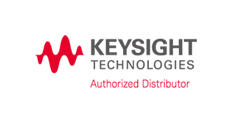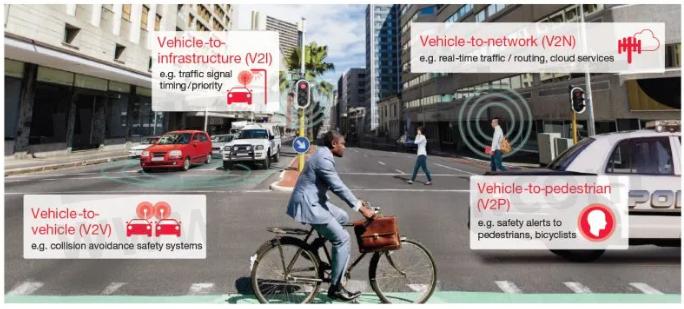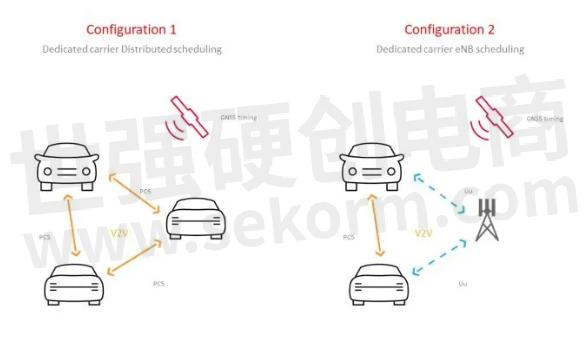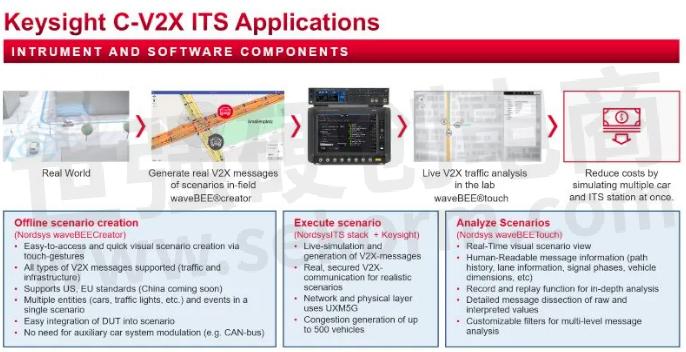C-V2X Certification – Necessary or Just Nice to Have?

At the September 2020 OmniAir Global Plugfest, NXP Semiconductors CTO Lars Reger started his keynote by asking,“Wouldn't it be great if you could know in real time what is happening outside your line-of-sight? Wouldn't it be great to know when a car drives to the crossroad long before you can see it?”
Fewer accidents and greater road safety are central to the vision for automated vehicles (AVs). Enabling that vision requires greater situational awareness and the ability to inform the car and its drivers what is happening a mile in front of them, foreseeing what's likely to happen next, and automatically taking preemptive actions.
Cellular vehicle-to-everything (C-V2X) technology provides see-through, 360-degree, non-line-of-sight (NLOS) sensing in good, as well as adverse weather conditions to enhance the functionality and safety of autonomous driving – as shown in Figure 1. C-V2X complements line-of-sight (LOS) sensors such as radar, lidar, camera with information beyond their reach, and allows the vehicle to make more informed and coordinated decisions. Whereas LOS sensors cannot indicate vehicle or driver intent, C-V2X conveys intent by sharing sensor data – resulting in a higher level of predictability in traffic situations such as lane changes, variable speeds, or road hazards.

Figure 1: C-V2X Applications (Image courtesy of Qualcomm)
C-V2X Use-Cases
The 5G Automotive Association (5GAA) has been instrumental in identifying use cases for C-V2X and has grouped them in the following categories:
◼ Safety: Emergency braking, intersection management assist, and collision warning are examples of safety use cases. Most of the use cases apply equally to autonomous vehicles as well as human drivers, with a few exceptions.
◼ Vehicle Operations Management: Use cases in this group include sensors monitoring, software updates, remote support; they are provided by automotive original equipment manufacturers (OEMs) to perform vehicle maintenance and monitoring.
◼ Convenience: Use cases in this group include assisted and cooperative navigation, autonomous parking, and infotainment.
◼ Autonomous Driving: This group includes use cases pertaining to Levels 4 and 5 of autonomous driving, tele-operation, downloading of maps, and cooperative interaction between vehicles to be efficient and safe.
◼ Platooning: These use cases are of interest to transport companies and address applications such as establishing and dissolving a platoon, determining position and managing distance in a platoon, and control of platoon in steady state.
◼ Traffic Efficiency and Environmental Friendliness: Examples of use cases are green light optimal speed advisory (GLOSA), traffic jam information, and routing advice.
◼ Society and Community: Use cases here include emergency vehicle approaching, traffic light priority, crash report – which are of value for vulnerable road user protection, emergency vehicles and services.
Day one use cases include safety features such as emergency electronic brake light and forward collision warning, do not pass warning, blind spot and lane change warning, vulnerable road user, road works warning, and intersection movement assistance.
Day two use cases include autonomous driving features such as cloud based sensor sharing and network availability prediction.
C-V2X testing will include pre-defined, executable tests for day one and day two use cases, as well as functional test of on-board units (OBUs) in different scenarios. In addition, it will test the different software stacks for the different regions.
Is Certification Important for C-V2X?
C-V2X is a relatively new technology in the automotive space, and regulations and standards regarding its operation and compliance are still in their infancy. Thus, certification is critical to ensure that implementation is correct, and to ensure interoperability – since there can be loopholes in the standard which results in different vendors interpreting the standard differently. Compliance with the relevant standards and specifications assures accurate and reliable communications between C-V2X and other connected car and driver information system, as well as other apps. Manufacturers who achieve certification can release approved products quickly and enhance their reputation in the market.
Specifically, with C-V2X, one of the biggest challenges is keeping up with the latest standards. Solutions need to be up-to-date with the latest evolution of C-V2X requirements, including releases that relate to 5G New Radio. Test solutions must provide a comprehensive and holistic approach to testing the RF, protocol, application-layers to meet quality, performance, and safety goals. Therefore, certification is important.
OmniAir Certification
OmniAir Consortium based in Alexandria (Virginia, U.S.) is a leading industry association founded in 2004 with the purpose of promoting certification for intelligent transportation systems. Certification has two components:
◼ Conformance
◼ Interoperability
Conformance ensures the technology meets the specification and it has been implemented the proper way; whereas interoperability ensures it will interface and work accurately with other solutions. OmniAir and its members work collaboratively with transportation stakeholders to develop requirements and specifications for technologies ranging from radio-frequency identification (RFID) tolling to dedicated short range communication (DSRC)-based connectivity. OmniAir has been leading and developing the C-V2X device certification program with top automotive industry members.
Members of OmniAir include public agencies, private companies, research institutions, and test laboratories. They participate in working groups and committees that develop requirements and specifications in multiple areas of transportation.
The automotive industry is not as familiar with the process of certification as other industries, and may wonder about the costs-to-benefits. However, certification from organizations such as OmniAir, provides assurance that devices meet minimum performance and interoperability requirements.
Test specifications for the physical layer (PHY) cover typical wireless transmit parameters such as output power, error vector magnitude (EVM) levels, in-band emissions, and receive parameters such as receiver sensitivity and throughput. Protocol tests will cover test cases for C-V2X's basic safety messages, wave short message protocol, as well as semi-persistent scheduling – its collision avoidance algorithm to handle wireless congestion.
A Holistic Approach to C-V2X Testing
It is important to take a holistic approach to testing of the RF, protocol, message, and application layers of C-V2X. Some of the important elements that help to speed up testing are:
◼ An intuitive user interface to simplify C-V2X measurements
◼ A global navigation satellite system (GNSS) emulator to generate signals for realistic GNSS
◼ A 5G measurement platform to protect initial investments and accelerate deployment of 5G NR that will enable advanced safety features.
The RF, protocol, message, and application layer tests should cover both interfaces: User-to-UTRAN (Uu) as well as direct communication PHY sidelink (PC5) as shown in Figure 2.

Figure 2: PC5 and Uu interfaces.
Testing can include in-lab testing (for development and interoperability testing), in-field monitoring (test track monitoring and recording), and in-vehicle drive test (monitoring, recording and logging).
OmniAir has certified Keysight's C-V2X test solution (Figure 3) for PHY and protocol conformance based on the consortium's LTE-V2X based test procedures 761, 762, and 765. This enables an OmniAir authorized test laboratory with Keysight equipment, to run a combination of manual and automated test cases developed against industry standards.

Figure 3: Keysight Technologies' C-V2X test system – first in industry to earn OmniAir Qualified Test Equipment status for C-V2X device testing.
Conclusion
At the September 2020 Plugfest, Lars Reger continued:
“Wouldn't it be great to see that a car is doing emergency braking, even if you cannot see the car because there is a truck in between you and that other car? Wouldn't it be great to know when the traffic lights are changing to green or to red? Wouldn't it be great to know there is an icy and slippery road directly in front of you?”
Panelists and presenters at the event concurred and stated their desire to see C-V2X deployed soon on roadways. Panelists felt that NLOS sensor capability may eventually become mandated, and C-V2X will become more than a nice-to-have. OmniAir certification will be critical to ensure those NLOS sensors and C-V2X works correctly in all driving and traffic scenarios.
- +1 Like
- Add to Favorites
Recommend
- Keysight Technologies Acquires Quantum Benchmar, Augmenting Keysight‘s Quantum Portfolio
- Keysight First to Gain OmniAir Qualified Test Equipment Status, Accelerating C-V2X Device Certification
- Keysight First to Gain GCF Approval of Cases for Validating 5G New Radio mmWave Devices in Standalone Mode
- Keysight Massively Parallel Board Test System Selected by LACROIX in Automotive Printed Circuit Board Manufacturing
- Keysight, TIM and JMA Wireless Join Forces to Showcase O-RAN Technology at Mobile World Congress 2021
- Keysight, Xilinx and Cisco Showcase Solutions that Support Smooth Migration from 4G LTE Networks to 5G Open RAN
- Keysight Unveils the First Media Access Control Security Test Solution for High Speed Ethernet
- Keysight, MediaTek Join Forces to Establish 5G Connectivity Based on 3GPP Release 16 Specifications
This document is provided by Sekorm Platform for VIP exclusive service. The copyright is owned by Sekorm. Without authorization, any medias, websites or individual are not allowed to reprint. When authorizing the reprint, the link of www.sekorm.com must be indicated.






























































































































































































































































































































































































































































































































































































































































































































































































































